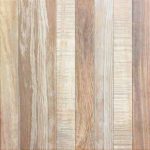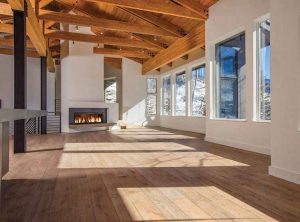
FLOORING AND CARPET OPTIONS BRING STYLE TO THE SURFACE
BY LISA CARTON & SARAH BETTS
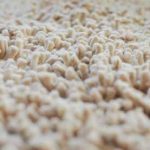
Your style, that sense of what’s “right,” design- and color-wise, is reflected wall-to-wall throughout your home. It’s evident in your choice of furniture, your selection of artwork, in the lighting, and more. That style lives and expresses itself from room to room, indoors and out.
It’s only natural that your personal aesthetic would drive your flooring choices and impact your home’s interior beauty—its design, décor, comfort, livability, and upkeep. A spectacular floor—whether made of artfully painted wood, stately houndstooth tiles, or even stained concrete—will catch your eye at every step. WOOD – CLASSIC, VERSATILE, AND DURABLE Hardwood floors are commonplace in homes today, but this has not always been the case. In fact, the popularity of hardwood has risen and fallen as trends change. In the early 1800s, hardwood floors were the domain of only some of the wealthiest homeowners. Prior to the development of side-matching technology in the 1880s, which created the tongue and groove formation found in most hardwood floors today, wood floors were custom-crafted by hand and often took years to complete. Almost a century later the popularity of hardwood floors boomed due to new milling technology and
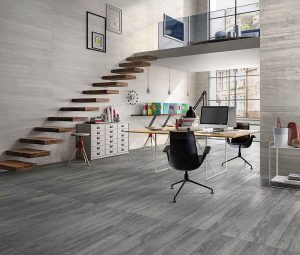
installation techniques. Then, hardwood went back to a rarity as carpeting was approved as part of 30-year mortgages.
Today though, people understand the draw of hardwood. A material that can take a space from modern to rustic depending on the materials chosen, hardwood is versatile in terms of look. Hardwoods can be sourced from reclaimed projects in random widths for a more rustic space, while a wide-plank vertical grain wood offers a more modern feel. Adding texture to a flooring, whether it be wire-brushing, saw marks, or hand-distressing, will significantly alter the look and feel of a room as well.
WARM-TONED GREYS STEAL THE SHOW
Designers note that grey is still a popular wood color for 2016 and 2017. Greys are taking on some warmth with brown undertones; the look is versatile as it works with a number of palettes. Beyond trends, most people care about the durability of their flooring and wood hits medium marks for durability. In high-traffic kitchen areas, wood can dent, stain, or scratch. But you can always think about those marks as part of your family’s lived history in a house and know that you’ll have a story to tell.
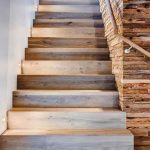
TILE
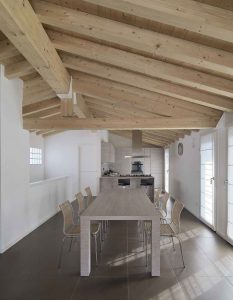
LET YOUR IMAGINATION RUN TILED
Tiles have an illustrious history, with samples of early clay and mud tiles found 7,000 years ago, and decorative tiles found in Egypt dating back to 4,000 BC. Tile, whether it is natural stone, porcelain, ceramic, or a mosaic, adds unique personality to each environment,” says Zach Baker of Earth Elements Design Center, Montana-based experts in flooring and custom finishes. “Without a doubt, it is one of the most creative ‘permanent’ finish selections made during the process of building or renovating.”
Baker and the Earth Elements team see tile as both a practical and aesthetic addition to a space. “Not only are you personalizing and enhancing a space,” he says, “you are often catering to how the area is being used. Porcelain, for example, is one of the most durable tile options to use on a floor, it is essentially maintenance-free and resists the wear and tear in wet or frequently-used areas where wood flooring or carpet may not be a great option. When secondary residences, rentals, or even commercial spaces are being built, typically the owner prefers to avoid materials that require constant care and maintenance. This is a great example of matching your material to use—in cases like this tile is often the best answer.”
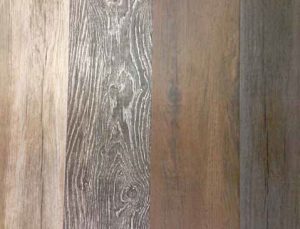
At Earth Elements, the goal is to ensure that clients are informed about the appropriate material use based on the function of the space, Baker explains. When it comes to tile though, there are seemingly unlimited options. From entryway floors to kitchen backsplashes, shower walls, and even an in-home dog wash, the Earth Elements team has seen a wide range of tiles put to great use.
The benefits of using tile are extensive. In warmer areas tile is cooler in the summer months, and it is a great benefit for those who suffer from dust-related allergies. Tile is also resistant to fire, moisture, odor, and fading.
TODAY’S ADVANCEMENTS
In the last few years, many innovations have revolutionized the tile industry. Ink-jet technology is utilized to achieve authentic stone appearances or very refined, intricate designs. Baker and his team recently met the owner of Red Rocks Tileworks, who watercolors designs, then turns them into the print for the porcelain tile they manufacture. “There are endless possibilities,” says Baker.
With all of the technology available, tile is constantly being revolutionized,” Baker explains. “A few examples include porcelain that mimics natural stone but doesn’t require the maintenance of natural stone, or wood tile that resists scratching and staining as opposed to wood floors—perfect for a home with children, dogs, or ski boots.”
Baker and the Earth Elements team have seen some creative advancement in the tile industry as well, including the creation of three-dimensional tile and intricate mosaics. “We have seen some of the most art-gallery-worthy tile in the last few years,” says Baker. “It is unbelievable and exciting to watch the industry revolutionize itself on a daily basis.”
TILE TRENDS
Given the many practical and aesthetic advancements in the tile industry, trends are changing quickly. “Whatever I say is the trend at the moment will change in as quick as a few months,” says Baker. “We 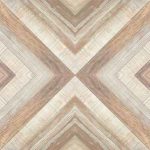 watch the grey versus beige phase ebb and flow, but one trend that hasn’t ceased over the past few years is textured tile. Whether it be chiseled natural stone or geometric gold-plated hexagons, the textured and three-dimensional tile trend is going to be what we continue to see at trade shows and product launches. This year the Earth Elements team is noticing that tile is replacing paint and wallpaper as the favored wall covering as well. No longer limited to floors and countertops, the versatility of this material is lending itself to a lot of creative and unique uses.
watch the grey versus beige phase ebb and flow, but one trend that hasn’t ceased over the past few years is textured tile. Whether it be chiseled natural stone or geometric gold-plated hexagons, the textured and three-dimensional tile trend is going to be what we continue to see at trade shows and product launches. This year the Earth Elements team is noticing that tile is replacing paint and wallpaper as the favored wall covering as well. No longer limited to floors and countertops, the versatility of this material is lending itself to a lot of creative and unique uses.
FROM THE ENVIRONMENTAL STANDPOINT
Green materials are in high demand in the building industry these days. Looking to decrease their environmental footprint, clients are building homes and sourcing materials that are less destructive and more cooperative with the surrounding environment. But it’s not just about where the materials come from and how they’re made, Baker explains. “At the end of the day, any products being used in the building industry are going to have an impact on the 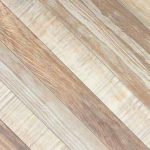 environment, unless they are truly 100 percent reused or recycled from a previous purpose,” says Baker. “The best thing that we in the industry can focus on is educating and guiding clients to use materials they can picture themselves using for a lifetime. There are definitely products out there containing a fair amount of recycled matter within their composition, but the basics of environmental consciousness call for us to simply use less and use longer.”
environment, unless they are truly 100 percent reused or recycled from a previous purpose,” says Baker. “The best thing that we in the industry can focus on is educating and guiding clients to use materials they can picture themselves using for a lifetime. There are definitely products out there containing a fair amount of recycled matter within their composition, but the basics of environmental consciousness call for us to simply use less and use longer.”
CONCRETE
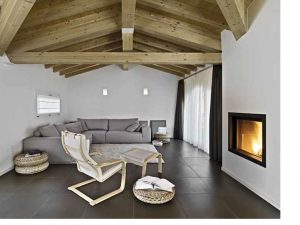
AS MUCH ART AS SCIENCE
Trendy, sleek, and durable, concrete flooring jumped from bare-bones utilitarian to modern chic in a New York minute. It’s not just for sidewalks any more; with a little craftsmanship concrete can be a stylish choice for indoor floors. Thanks to a multitude of color, texture, and finish possibilities, concrete lends itself to almost any décor.
Clint Isaacson, owner of Integrated Concrete Specialties in Jackson Hole, says that the increasing use of concrete in home finishes is dramatic. He’s had a steady stream of clients coming to him looking for concrete installation in the past several years and he’s seeing it explode in popularity in both new home development and existing home remodels.
“Concrete itself is becoming more popular in both rustic and modern building,” Isaacson explains. “It’s extremely attractive and versatile and it lasts a lot longer too.”
One of the first and most notable things people think about when shopping around for the right floor for their home is undeniably the look of the material. Isaacson feels that one of the benefits of concrete is that it has an incredibly versatile look, and a lengthy list of other benefits. “It’s hypoallergenic, easy to clean, requires very little maintenance, is environmentally friendly and wears fantastically. For areas like Jackson where people are active and dogs, kids, mud, and snow are in and out of the house all the time, concrete is really appealing.”
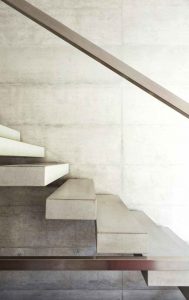
The craftsmanship that goes into making concrete surfaces desirable for the home is commendable too. Its surface can be finished in various ways—with natural dyes to impart subtle colors, epoxy coatings, and aggregates—and the whole surface can be crafted to have a textured feel or buffed appearance.
Special stains that contain elements that react to the lime in concrete can be painted or applied to the floor to make intricate designs and patterns. This customization is done in the early stages of mixing the concrete. However, water-based dyes and acid stains can also be used to add color to the surface after it has been poured. “I am doing a lot more in the modern realm right now,” says Isaacson, “like shiny white epoxy floors. We’ve also been doing a lot with overlay systems that give you a really polished look.”
The overlay system, Isaacson explains, is a technique of laying concrete over existing surfaces like tile or wood flooring. This reduces waste created from the removal of old materials and can help cover toxic substances such as asbestos. The finished product can be highly customized depending on the way the overlay is applied and finished, giving variations in color and texture. “Acid stains,” Isaacson explains, “which can impart a nice a warm look to the surface, are really popular right now as well.”
CONCRETE IS GREEN
Concrete is good for the earth. Really. Concrete doesn’t deplete natural resources, requires less energy than other floor types to produce, and is made and poured locally. Additionally, concrete helps create better indoor air quality because it inhibits mold,
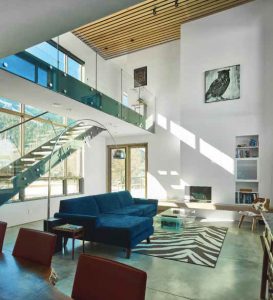
mildew, and odors, contains no potentially harmful VOCs, (volatile organic compounds), and can be finished with zero-VOC sealers. As Isaacson explains, concrete can also be recycled, and the surface cuts down on the need to discard waste, such as scraps of flooring and old materials that can be overlaid.
“Using polished concrete offers LEED points for green building certification,” says Isaacson, “and you can use non-toxic water-based dyes and sealants in lot of the systems that we cover.”
THE WARMTH OF CONCRETE
Although we traditionally think of concrete as a ‘cold’ material, it’s actually a great material for absorbing sunlight and dispersing that heat throughout the house. This is why many solar passive houses have concrete floors. Of course, concrete can appear aesthetically cold, but it can easily be warmed up by teaming it with warmer-looking materials and custom finishing.
Concrete also works well with radiant heating. The substance has a lot of thermal mass, Isaacson explains, meaning it absorbs and stores heat energy really well. This translates to a reduction in energy bills and a nice, inviting warm flooring for the home. “Concrete floors, says Isaacson, “are great at staying warm when heated in the winter and keeping cool in the hotter months of summer.”
RUGS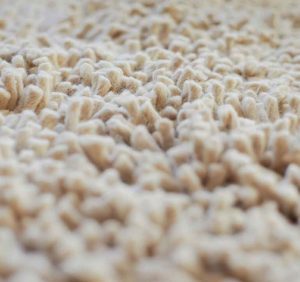
WORRY-FREE HOME DECOR
When you talk with Cori Brown of Summit Source in Salt Lake City, you’re immediately put at ease by the level of expertise Brown brings to flooring projects. There are many worries when it comes to decorating your home. Will it look beautiful? Will it last? Will it be comfortable? “When you are planning a project, big or small—these questions are bound to pop up,” says Brown, who has assisted home and business owners in the valley, taking worry out of the design process for over 10 years.
WILL IT LAST?
How can you make sure your new décor will hold up? First, Brown stresses the need to be honest with yourself about your lifestyle. “If you have rambunctious kids and pets, you probably want to steer clear from all-white.” You can, however, find beautiful products that are durable and stain-resistant. Choose flooring products made of materials that resist spills and messes, as well as products with long-term warranties.”
Brown notes that the trend toward modern contemporary flooring continues to be very popular. “People are utilizing engineered hardwood floors which have a very strong appeal, and they really are indistinguishable from real wood. “Builders also seem to prefer the pre-finished floors because it keeps a project on schedule, and the home doesn’t need to be shut down for the lengthy sanding and staining process.”
CREATIVE CARPETING
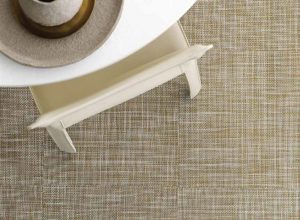
When the choices in carpet were limited to basic beige, designers treated it more often than not as a neutral background for room furnishings. Now, with numerous textures, patterns, and colors available, carpet is emerging as the focal point in some interior designs.“We’re seeing more texture and patterns and even flecks of color adding interest to basic backgrounds,” says Brown. “Also, variations in height and sculptured effects are offering a bolder look.”
Brandon May of Grand Design, a Jackson-based flooring company, is also seeing a wide variety of new carpeting styles and materials. “Sometimes, the subtlest of changes can have the greatest impact on someone’s perception of a space,” says May. “That being said, we take pride in offering our clients all of the options they need to choose a carpet that will be a bold statement or a neutral background.”
For May and his team at Grand Design, the technological advancements in carpet manufacturing are pretty exciting too. “There are so many remarkable new technologies now that the whole game is really changing,” says May. “We’re looking at fibers being changed at the molecular level to offer lifetime stain resistance, fibers being produced with corn oil to increase their silky-soft feeling, and carpets being produced from recycled plastics in such a way that they still feel very much like nylon carpets.”
In addition, May has been finding that wool carpets are really in right now, and for great reasons. “We’ve seen a revolution in wool carpets to make them slightly thinner, and therefore much more affordable for the majority of clients,” he explains. “Wool is, of course, the leader in sustainable carpeting, and is naturally stain-repellent, naturally fire-retardant, and the most durable of all carpet options.”
BEYOND THE BASICS – OTHER OPTIONS AND WHAT’S RIGHT FOR YOU
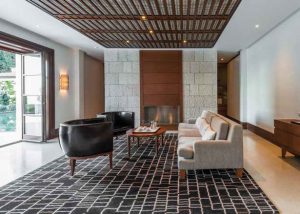
“Manufacturers are getting really creative with flooring materials nowadays,” says May of Grand Design. “We’re seeing sustainable materials like sorghum stalks, post-industrial wood products, linseed oil, recycled leather, and cork all being used in really sleek presentations.”
There’s no one-size-fits-all answer for flooring, even as new materials come into play and seem to take center stage. A number of elements need to be taken into consideration, May explains, in order to determine the flooring that’s right for you. In extreme climates like that of Jackson, he says, “its all about the quality of the materials, which is what we focus on with our products. There are always tricks to make any type of material work in the appropriate climate.”
Thinking about the wear your floor will experience and the type of feel you want your space to have are important too. “Wool, porcelain, and hardwood are the classic examples of materials that stand the test of time,” says May, “but with all of the new technologies that have arisen, all quality flooring options are made to last for a very long time.” What it comes to, and what the Grand Design team feels is most important, is finding a material that speaks to the client’s lifestyle and needs as well as the desired character of the space.

